- Obituary
- National
- Obituaries
Titan of industry strode the Australian business landscape
By Tim Boreham
RODERICK HOWARD CARNEGIE November 27, 1932 to July 14, 2024
For more than four decades, Sir Rod Carnegie strode the Australian business landscape as an industrialist, pioneering management consultant, ubiquitous company director and advocate of genuine free markets and labour reform.
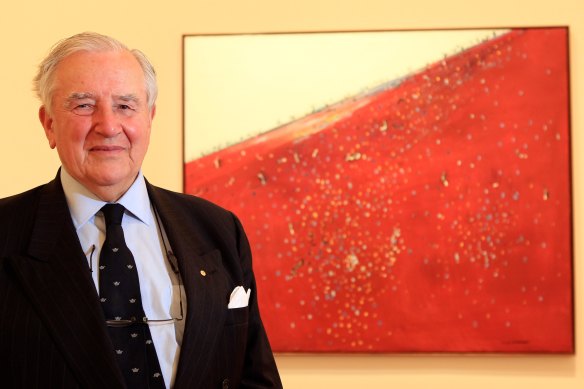
Business leader Sir Roderick Carnegie was a passionate collector of Australian art. He is pictured in 2012 at the NGV’s Fred Williams: Infinite Horizons exhibition.Credit: Rebecca Hallas
Carnegie, who died aged 91, exemplified impeccable establishment connections with his sandstone college pedigree, Toorak abode, Sorrento holiday retreat and Melbourne and Australia Club memberships.
Known in some circles as “Rod the god” because of his imposing presence, Carnegie was described by one interviewer as an “urbane imposing figure with a straight-from-the-shoulder style”.
But in manner and spirit, he was anything but a classic conservative. Never afraid to usurp the status quo, he remained outspoken on the need to instil better practices and create a genuinely competitive nation.
Indeed, Carnegie was even once dubbed as a “dangerous socialist”, partly because of his friendship with fellow Oxford University alumnus Bob Hawke.
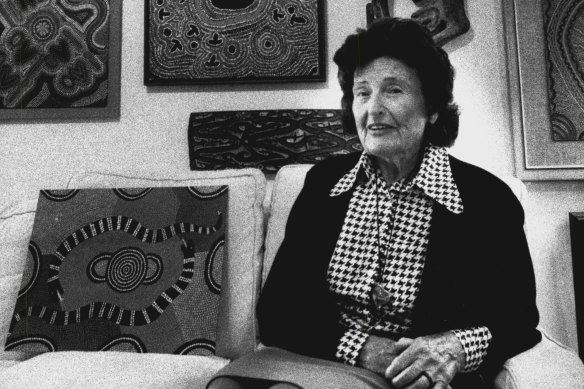
Margaret Carnegie with part of her collection of Aboriginal art in 1989.Credit: Andrew Taylor
Carnegie was born in Melbourne in 1932, the eldest of four children and only son of Douglas and Margaret.
Douglas ran a piano business founded by a Scottish descendant and also bred poll hereford cattle at his Kildrummie stud in Holbrook, NSW.
Margaret (nee Allen) was a well-known art collector – particularly of Indigenous art – and a writer and artist in her own right.
Carnegie was educated at Geelong Grammar, Trinity College, Melbourne University and then Oxford, where he studied arts and agricultural economics.
While a diligent but not outstanding student, the keen oarsman found time to join the Oxford University Boat Club, of which he became president in 1957.
By that time, Carnegie’s career-winning traits were becoming evident. As president, Carnegie introduced a strict training regimen and American techniques. During a critical race against arch foes Cambridge, a fellow Oxford rower succumbed to exhaustion and Carnegie took over his oars in a valiant but vain attempt to retake the lead.
Rounding off his academic resume with a Harvard MBA in 1959, Carnegie joined the management consultancy McKinsey & Co, working in the United States and Europe. In 1962, he returned to Melbourne to found McKinsey’s Australian practice and then returned to New York as a director of the parent company.
Carnegie’s Who’s Who entry lists no fewer than 40 roles – paid and honorary – including president of the Business Council of Australia between 1987 and 1988.
In arguably his most formative role, Carnegie joined mining house CRA (Conzinc Rio Tinto) as a finance director in 1972. He then served as CEO and chairman between 1974 and 1986, in an era when holding such dual roles was not seen as a governance faux pas.
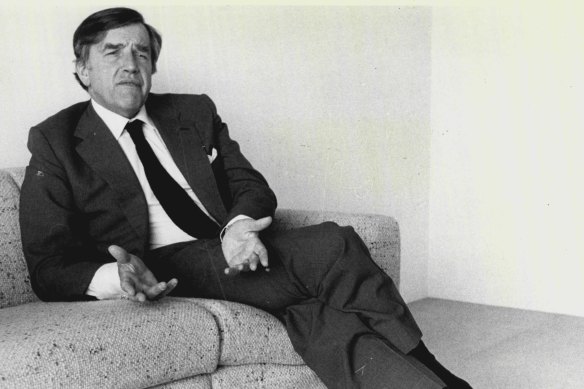
Sir Roderick Carnegie in 1987.Credit: Fairfax Media
Sharing digs with BHP in the renowned Collins House “tower of power” – 360 Collins Street in Melbourne’s CBD – CRA strode the corporate stage like a colossus.
In the Carnegie era, CRA rapidly expanded its coal, bauxite and iron ore assets, the latter built on Hamersley Iron’s Pilbara deposits unearthed by Lang Hancock in the early 1960s.
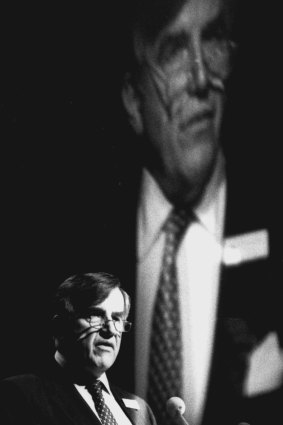
Carnegie addresses GIO shareholders in 1992.Credit: Amanda Watkins
CRA also discovered the Argyle diamond mine in Western Australia, doubling world diamond production overnight and becoming the world’s principal source of rare pink, red and violet diamonds.
The company also acquired a 30 per cent interest in Chile’s Escondida copper mine, which continues to be a major global supplier of the industrial metal.
Never one to keep his own counsel, Carnegie took a keen interest in overhauling management and workplace culture at a time when the Pilbara operations were riven with industrial unrest. But his approach to mitigating what he dubbed as “industrial lawlessness” was not text-book union bashing.
His overriding tenet was that individuals needed to be held responsible for a company’s output – and should be rewarded or reprimanded accordingly.
He acknowledged that management could not demand the loyalty of its workers if they were not competent. He presided over a radical thinning of CRA’s management structure and pioneered individual workplace contracts.
“The driving force has to be management’s commitment to make the workplace one in which people want to really give as much of themselves as they would to [a] football team,” he said later.
“That means changing from the adversarial relationship between the manager and subordinates to a much more collegiate relationship.”
Delivering the HC Coombs Address in 1996, Carnegie presciently pressed the need for corporations to act in an ethical and sustainable manner. “Without a sound moral underpinning, an institution founders approximately 10 to 20 years later,” he said. “By building an institution which will carry on doing this on a sustainable basis, you can face your own death with equanimity.”
Unlike BHP, CRA was controlled by its London shareholder Rio Tinto Zinc Corporation and tensions emerged as Carnegie sought to “Australianise” the local arm. RTZ and CRA merged in 1996 and reverted to the old Rio Tinto name – but it was agreed the Australian arm would remain locally headquartered.
Post CRA, Carnegie formed the property group Hudson Conway in Melbourne with racing figure Lloyd Williams and the late Ron Walker.
The trio’s timing initially was fortunate, with the fledgling company snapping up CBD properties at bargain rates during the prevailing property slump.
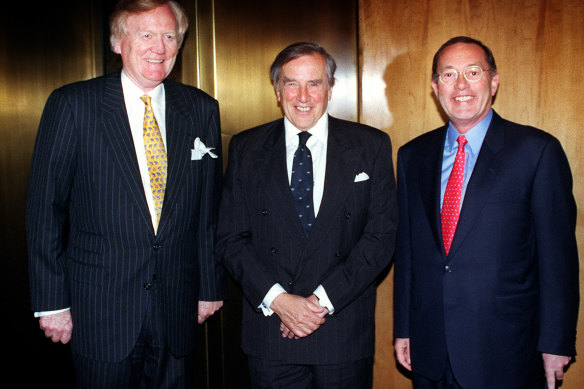
Carnegie is flanked by Ron Walker (left) and Lloyd Williams after a Hudson Conway annual meeting.Credit: John Woudstra
But Hudson Conway lacked a big-ticket project before the Jeff Kennett-run state government awarded the company the mandate to build and operate Melbourne’s new casino (later sold to Kerry Packer).
Carnegie sold his Hudson Conway holding in 1990 but remained chairman until 2008 when the company was privatised. In 1992, Carnegie became the only Victorian-based non-executive director of John Fairfax, then the owner of The Age.
At a time when ownership of the flailing publisher became a political hot potato, Carnegie faced awkward questioning given his ongoing role at Hudson Conway, which in turn had strong links with Packer, who was seeking to buy Fairfax.
At one Fairfax AGM, he was accused of seeking to remove The Age’s editor at the time, Bruce Guthrie, at the behest of Williams and – ultimately – Kennett.
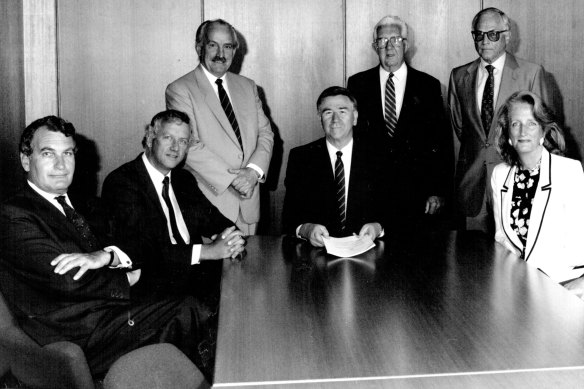
Lady Carmen Carnegie with fellow members of the trust to administer The Earth Exchange, a museum of minerals and mining in Sydney that closed in 1995.Credit: Fairfax Media
Among a raft of directorships, Carnegie was on the board of the ANZ Bank, Newcrest Mining, Myer and CSIRO, and served on General Motors’ advisory board and the Group of Thirty.
In 1959, Carnegie married Carmen Clarke, whose family were Western District grazing pioneers with links to the equally blue-blood Baillieu dynasty. Carmen died in 2008.
Their children – Mark, James and Charles – are well known in business circles. A prominent venture capitalist, Mark Carnegie formed investment firm MH Carnegie. Charles runs the management consultancy, Waypoint Group. His wife, Maile Carnegie, is the former head of Google Australia and a senior ANZ Bank executive. James Carnegie is chairman of Blackstone’s local private equity business.
Carnegie also inherited his mother’s passion for collecting Australian art. In the early 1980s, he suggested to the CRA board that the company spend $250,000 on artist Fred Williams’ series of paintings of the Pilbara iron ore region. “They thought I was mad – until I suggested that if they didn’t, then I’d buy them myself,” he recalled in 2012.

Carnegie in the gardens of his home at Woodend in 2010.Credit: Pat Scala
Carnegie and Carmen also owned the historic Flint Hill at Woodend, an expansive woodland estate with sweeping views of Hanging Rock and Mount Macedon.
But Carnegie’s life could have been cut tragically short. In September 1988, he was involved in a fatal car accident on the way to Flint Hill, suffering serious injuries including a collapsed lung.
Carnegie was fortunate the attending State Emergency Service included a voluntary doctor, who performed a life-saving procedure while Carnegie remained trapped in the vehicle.
Carnegie was knighted in 1978 and bestowed a Companion of the Order of Australia in 2003. The latter recognised his promotion of innovative leadership and competitive practices, as well as his contribution to health and the arts.
Carnegie was also a Trinity College Melbourne fellow, patron of the Australian Centre for Blood Diseases and a director of the Macfarlane Burnet Centre for Medical Research.
The Morning Edition newsletter is our guide to the day’s most important and interesting stories, analysis and insights. Sign up here.